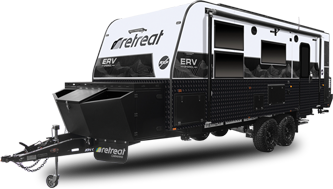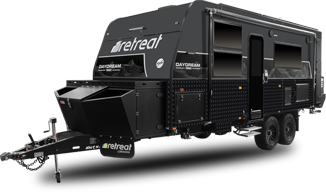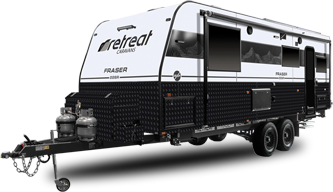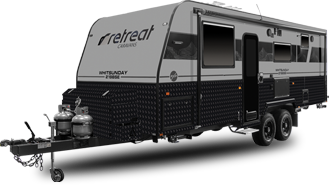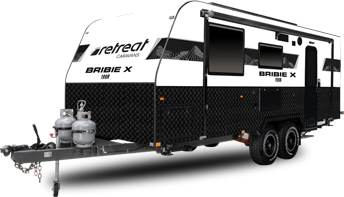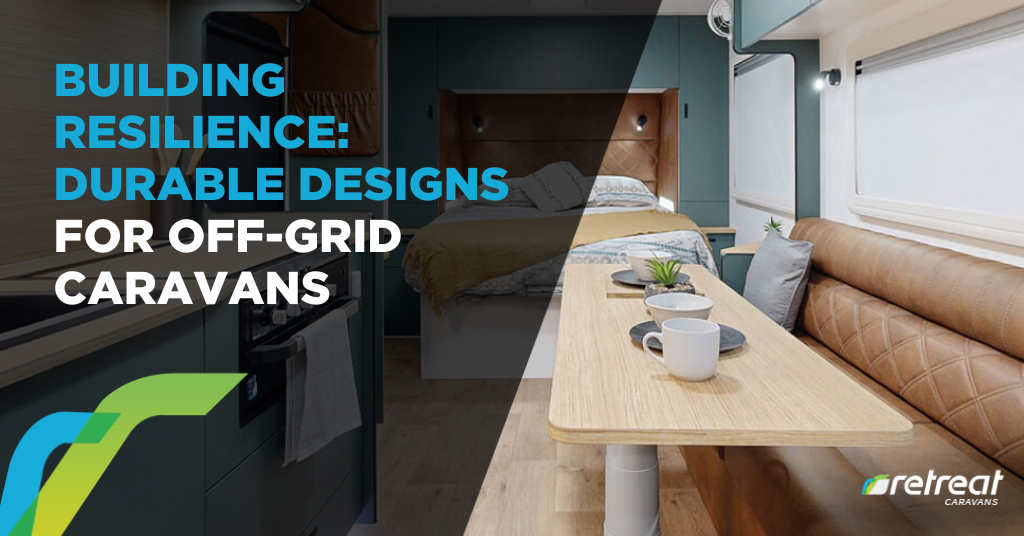
Building Resilience: Durable Designs for Off-Grid Caravans
Australia’s rugged outback doesn’t forgive poor design. Caravans built for the bush need more than looks—they need guts. As more Aussies chase freedom off the beaten track, the demand for luxury caravans that can also take a beating is rising fast. That’s where resilience steps in. In this post, we break down what makes a caravan truly built for off-grid life—and why it matters.
Built for the Wild: Why Resilience is Essential
If your van breaks down ten minutes from town, no worries. If it happens 400 km from the nearest servo, you’re in a world of hurt. This is the off-grid reality. You need gear that keeps going when help isn’t coming.
Resilient design means more than being “tough.” It means the whole setup—frame, power, plumbing, and storage—works together to keep you safe, powered, and comfy no matter where you are. It’s what lets off-grid caravans survive wild weather, rough tracks, and long stretches without supplies.
This is why Retreat builds with tested materials, smart tech, and strong layouts. The goal? Total self-reliance. When you camp remote, your caravan isn’t just your bed—it’s your power station, your water tank, your shelter. It’s home.
The Backbone: Materials That Withstand the Elements
Resilience starts with the bones. If the frame can’t take the hits, nothing else matters. In today’s best off-grid caravans, aluminium frames are leading the pack. Why?
- Aluminium resists rust
- It’s strong but light
- It handles vibration better than steel
Composite panels are another smart move. They’re tougher than old-school ply, offer better insulation, and seal up tight against dust and water. A good seal is key when you’re bouncing down red dirt tracks for hours.
Floors matter too. Rigid honeycomb floors are popular because they don’t rot and they’re light enough to save on fuel. Throw in some protective underbody coating, and you’ve got a rig that shrugs off sticks, stones, and sudden storms.
When it comes to choosing the right off-road caravan for your adventure, material quality and build strength should sit at the top of your checklist.
Energy Independence: Power That Doesn’t Quit
Solar power is a game-changer. But not all setups are created equal. A durable off-grid caravan doesn’t just slap a panel on the roof and call it a day.
You want:
- Multiple panels (300W or more total output)
- High-capacity lithium batteries (at least 200Ah)
- An inverter that handles your appliances
- A solid charge controller to keep things safe
Lithium wins over AGM every time. It lasts longer, charges faster, and gives more usable power. For serious off-grid travel, add a DC-DC charger to top up your batteries while you drive.
A smart energy monitor helps you track usage so you don’t get caught out. It’s not just about running the fridge—it’s about peace of mind.
Understanding the difference in energy systems can help you choose better, and understanding the differences between off-road and off-grid caravans is key to making that call.
Plumbing & Water: Holding Tanks that Hold Up
No water, no trip. It’s that simple. Resilient caravan plumbing starts with tanks that can handle heat, movement, and rough tracks.
Here’s what you want:
- At least 200L of fresh water
- Separate grey water tank for eco camping
- Strong polyethylene or stainless steel tanks
- Rock guards or bash plates underneath
Insulated pipes are a bonus if you’re heading into cold country. Some folks add water filtration systems so they can fill from rivers or rain catchments. Smart move if you’re out for weeks.
A good hot water system (gas or diesel) adds comfort and flexibility. And remember—leaks in the bush can ruin everything. So check your seals and fittings before every long trip.
Staying prepared is half the battle, so use these tips for preparing your off-road caravan for harsh environments to make sure your plumbing stands up to the task.
Climate Control: Staying Comfortable in Any Weather
You might love the sun, but your batteries and your body don’t. Good design means your van stays cool in heat and warm in cold, without draining all your power.
Insulated walls and roofs make a big difference. Look for caravans with closed-cell foam insulation or composite walls. Cross-ventilation matters too—windows on both sides let breezes flow through.
For power-efficient cooling, fans beat air-con in mild weather. Diesel heaters are great for chill nights. Some newer models even offer hybrid systems that use a bit of everything.
Adding shade awnings and roof ventilation hatches can drop interior temps fast. And thermal curtains or block-out blinds help you control the light and heat inside.
Storage Solutions: Built-In Practicality
Out bush, space is gold. You need room for tools, food, clothes, and maybe even bikes or boards. But it’s not just about how much—it’s about how well it’s packed.
Smart storage ideas include:
- Full-width tunnel boots
- Slide-out pantries
- Fold-down external tables
- Rear storage pods or toolboxes
Look for heavy-duty drawers with proper latches. Cheap fittings rattle loose on rough tracks. And use tie-down points—nobody wants flying saucepans on a corrugated road.
Think vertical too. Wall pockets and ceiling nets keep gear handy without hogging floor space.
Tech that Works When You Need It Most
Modern caravans aren’t just trailers—they’re tech hubs. But tech only adds value if it holds up and helps you stay safe.
Key tech features for resilience:
- GPS trackers
- Tyre pressure monitors
- Satellite comms or Starlink
- Water level indicators
- Battery and solar monitors
Offline navigation is a must—no signal, no worries. Good off-grid setups come with waterproof power ports, sealed switches, and dust-proof electronics bays.
These extras may seem small, but they make a big difference when it counts.
Real-World Example: The Red Centre Loop
Take the Perkins family. In 2024, they did a full loop through the Red Centre—Alice Springs, Kings Canyon, Uluru—over four weeks. They travelled in a 21ft off-grid caravan packed with solar panels, 300L of water, a full lithium setup, and a hybrid diesel heater.
Temperatures swung from 42°C in the day to 5°C at night. Roads were rough. They hit rain, wind, and days with no signal. But their rig held strong.
No leaks. No breakdowns. Just dust, sunsets, and freedom. Their van gave them the confidence to say “yes” to the trip of a lifetime.
What the Future Holds for Off-Grid Caravan Design
The next wave of resilience? Smarter tech and lighter builds. Here’s what’s coming:
- Solar paint and ultra-thin panels
- AI-driven energy management
- Recycled composite bodies
- Bio-based insulation
- Self-levelling suspension
Builders are already testing AI-powered solar systems that optimise panel angles on the fly. Modular design could also make future caravans easier to repair or upgrade on the road.
It’s all about pushing further without pushing harder. As more Aussies explore remote travel, off-grid caravans will keep evolving to meet the challenge.
Frequently Asked Questions
1) How much water storage do I really need for off-grid trips?
At minimum, aim for 200L of fresh water. If you’re going off-grid for a week or more, especially with two or more people, bump that to 250–300L. You’ll also want a grey water tank, which is now required in many eco-sensitive camping zones. If you’re heading into dry areas or planning long bush stays, consider a portable bladder or secondary tank. To stretch your water, install a low-flow showerhead, collect rain when you can, and reuse water for tasks like washing down gear.
2) Are lithium batteries worth the upgrade from AGM?
Yes. Lithium batteries are lighter, last longer (up to 10 years), charge faster, and provide more usable energy. An AGM battery gives you around 50% of its rated capacity. Lithium? Around 80–90%. If you’re serious about off-grid travel, especially with fridges, fans, or other high-draw gear, lithium is the smarter choice. It also handles deeper discharges and can be mounted in tight spots. The upfront cost is higher but worth it over time.
3) What’s the difference between off-road and off-grid caravans?
Off-road caravans focus on toughness—think heavy-duty chassis, strong suspension, and rugged tyres. They’re built to handle rough tracks. Off-grid caravans focus on self-sufficiency—solar panels, water tanks, and power systems that let you stay away from powered sites. Some caravans offer both. Here’s a deeper dive into understanding the differences between off-road and off-grid caravans.
4) How can I keep my caravan cool without using too much power?
Insulation is your best friend. Make sure your walls, roof, and floor are well-insulated. Use fans instead of air-con when temps aren’t extreme. Open windows early and close blinds before the heat hits. Add awnings and park in shade where possible. Roof vents and skylights with covers help too. If you’re using a generator, choose energy-efficient air conditioning to stretch fuel. Power-saving tips go a long way when you’re out bush.
5) What’s the best caravan size for off-grid travel?
That depends on how long you’re staying off-grid and how many are travelling. Solo or couples? A 16–18ft van might be enough. Families often need 20–22ft for comfort and storage. Bigger vans carry more water, batteries, and gear—but they’re harder to tow and access some remote spots. Look for a layout that gives space and function without overloading your tow vehicle. Smart design beats size when it comes to off-grid travel.
Stay Strong, Stay Free
Caravanning off-grid is more than a holiday—it’s a test of your setup, your planning, and your mindset. Building resilience into your caravan means fewer breakdowns and more sunsets. It gives you the confidence to push further and stay longer. That’s the dream, right?
As more travellers head bush, resilient design will only grow more vital. Whether it’s smarter batteries, tougher frames, or new tech, the focus is clear: strength, independence, and safety.
If you’re ready to start your off-grid journey, check out the latest innovations at Retreat Caravans. We’re building caravans tough enough to take you anywhere—and keep you there.
See below for our full range of caravans, all carefully designed with you in mind:



